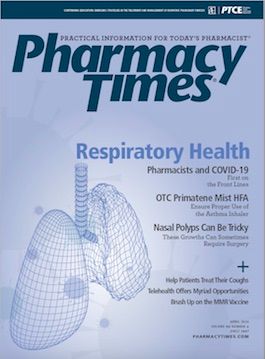Publication
Article
Pharmacy Times
Ensure the Proper Use of Primatene Mist HFA
Author(s):
Pharmacists can educate patients about the nonprescription asthma inhaler that recently returned to the market.
Primatene Mist HFA, a new formulation of a former prescription-only product became, the only FDA-approved OTC asthma inhaler available in the United States in November 2018.1,2
This formulation’s active ingredient is epinephrine. The inhaler is available in a strength of 0.125 mg per spray, and it is indicated for the temporary relief of mild symptoms of intermittent asthma, such as shortness of breath, tightness in the chest, and wheezing in individuals 12 years and older who had previously received a diagnosis of asthma.3 Primatene Mist HFA is not intended for individuals with moderate or severe asthma.2 The FDA approved a previous formulation of Primatene Mist more than 5 decades ago. The original version was formulated using chlorofluorocarbon (CFC) propellant, but that was withdrawn from the market in 2011 as a part of overall efforts of the Montreal Protocol of Substances that Deplete the Ozone Layer and the 1990 Clean Air Act to phase out ozone-depleting CFC propellants.4
The OTC inhaler includes hydrofluoroalkane, a non-CFC propellant. The product has a built-in spray indicator, a pressurized metal canister, and updated instructions for use and cleaning.2
During counseling, pharmacists should advise patients to adhere to the manufacturer-recommended dosage of 1 to 2 inhalations per individual use. Patients should also wait a minimum of 4 hours between doses and not use more than 8 inhalations within 24 hours.1 Patients must activate/prime inhalers before initial use and wash inhalers after each day of use. However, remind patients that a change in the color of the mouthpiece is expected over time.1 The dose indicator provides the number of sprays remaining in the inhaler. The remaining number of sprays updates after every 20 sprays. Advise patients to replace inhalers when 20 sprays are left.1 The Primatene Mist HFA packaging includes a vital asthma alert, explaining that because asthma may be life-threatening, patients should contact their primary health care providers if (1) they are not better within 20 minutes of using Primatene Mist HFA, (2) their symptoms exacerbate, (3) they need more than 8 inhalations in 24 hours, or (4) they have more than 2 exacerbations in a week.1 These are all signs that their asthma may be getting worse. Patients should also contact their primary health care providers if they experience any adverse events while taking Primatene Mist HFA.1
Let patients know that Primatene Mist HFA is not a replacement for long-term maintenance medications and that they should not stop taking any asthma treatment prescribed by their primary health care providers.2,5 Contraindications include concomitant use of monoamine oxidase inhibitors (MAOIs), including the 2-week period after stopping MAOIs.1 Practitioners should exercise caution if the patient is taking drugs that contain phenylephrine, pseudoephedrine, ephedrine, or other stimulants or if the patient has benign prostatic hyperplasia, cardiovascular disease, diabetes, hypertension, narrow-angle glaucoma, a psychiatric disorder, seizures, or thyroid disease.1
Primatene Mist HFA should be stored at room temperature, between 15˚C and 25˚C (59˚F and 77˚F).1
During counseling, remind patients with asthma to be aware of potential asthma triggers, to seek routine monitoring by primary health care providers, and to recognize that concomitant conditions, such as allergic rhinitis, gastroesophageal reflux disease, and smoking, can worsen asthma symptoms. Pharmacists should also recommend that patients with other medical conditions, persistent and severe asthma symptoms, and no prior diagnosis of asthma be referred for further medical evaluation and not use Primatene Mist HFA unless directed by a physician.
Pharmacists can also use the educational guide on the manufacturer website to inform patients about the proper use and care of Primatene Mist HFA inhalers.6
Yvette C. Terrie, BSPharm, RPh, is a consulting pharmacist and a medical writer in Haymarket, Virginia.
REFERENCES
- Primatene Mist HFA drug label. FDA website. accessdata.fda.gov/drugsatfda_docs/label/2018/205920Orig1s000lbl.pdf. Accessed March 10, 2020.
- FDA statement on approval of OTC Primatene Mist to treat mild asthma [news release]. Silver Spring, MD: FDA; November 8, 2018. www.fda.gov/news-events/press-announcements/fda-statement-approval-otc-primatene-mist-treat-mild-asthma. Accessed February 9, 2020.
- Primatene Mist FAQs. Primatene Mist website. primatene.com/faqs.aspx. Accessed February 7, 2020.
- US Department of Health & Human Services. Primatene Mist with chlorofluorocarbons no longer available after Dec. 31, 2011. FDA website. wayback.archive-it.org/7993/20170112011259/http:/www.fda.gov/ForConsumers/ConsumerUpdates/ucm247196.htm. Accessed February 9, 2020.
- Why Primatene Mist may not be the best medicine — discuss your asthma treatment with your allergist. American Academy of Allergy, Asthma & Immunology website. aaaai.org/conditions-and-treatments/library/asthma-library/primatene. Accessed February 9, 2020.
- Primatene Mist. Primatene website. primatene.com/pdf/how-to-use-inhaler.pdf. Accessed March 10, 2020.







